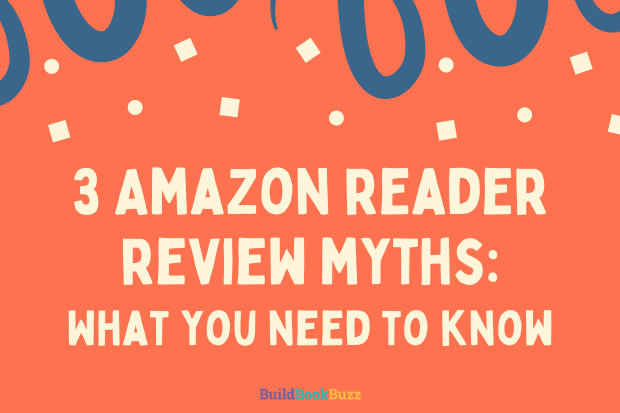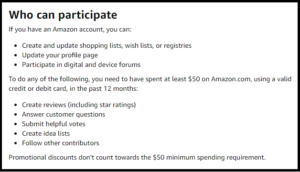3 Amazon reader review myths: What you need to know
What Amazon reader review myths do you hear most often? We de-bunk three of the most common. You might be surprised by what you learn.
Authors are asking for and receiving advice from other authors about how to get reader reviews on Amazon.
Much of the advice is excellent. Some of the most helpful information comes from the “Here’s how I did it” stories that many are willing to share.
There’s a downside to this authors-talking-to-authors back-and-forth, though. Some of the advice is wrong.
That’s understandable, because it seems like the “facts” do change regularly. Still, repeating information without verifying it first sometimes adds to the confusion. (“I heard in another group . . .” isn’t enough.)
The “rules” are easy to verify. What’s harder to confirm is what could be considered the unwritten rules surrounding Amazon reader reviews.
The mystery of the disappearing review
For example, there’s a lot of discussion around reader reviews being removed or blocked.
People speculate that it happens when Amazon identifies social media connections between a reviewer and the book’s author. I haven’t seen this verified, but I did find this statement in the Community Guidelines: “If we find unusual reviewing behavior, we might limit the ability to submit reviews. If we reject or remove someone’s review because it violates our promotional content guidelines, we won’t accept any more reviews from them for the same product.”
It makes sense, though. Amazon’s rules surrounding reviews for books and other products are designed to ensure honesty and integrity. Shoppers need to be able to trust reader/user reviews because they help them make purchasing decisions.
If reviews are biased, they’re useless.
If reviews are biased, they're useless.Click to tweetReader review myths and facts
Other specifics can be confirmed or refuted, though. Here are three Amazon reader review myths and what you need to know about them.
Reader Review Myth 1: You can’t give a reader a complimentary copy of your book in exchange for an honest reader review.
In October 2016, Amazon announced it would no longer allow product sellers to give free products in exchange for reviews. Books are exempt from that rule.
The last paragraph of the Amazon announcement with this information reads:
“The above changes will apply to product categories other than books. We will continue to allow the age-old practice of providing advance review copies of books.”
Reader Review Myth 2: Anyone can review a book on Amazon.
According to the retailer’s Community Guidelines, “To do any of the following, you need to have spent at least $50 on Amazon.com, using a valid credit or debit card, in the past 12 months”. The list of actions following that statement includes, “Create reviews (including star ratings).”
Reader Review Myth 3: You can’t review a book unless you bought it on Amazon. (Another variation: You must have an “Amazon verified purchase” to write a review.)
That is so not true, yet so many insist that it is.
I asked Amazon about this while writing “The Amazon reviews brouhaha and you.”
Here’s what an Amazon representative told me: “Anyone registered as an Amazon.com customer is entitled to write a product review. It doesn’t matter whether they bought the product from our website or not. Also, we encourage reviews on Amazon.com website, both positive and negative, verified or non verified as long as they adhere to our posted guidelines. Customer Reviews are meant to give customers unbiased product feedback from fellow shoppers, any reviews that could be viewed as advertising, promotional, or misleading will not be posted.”
Verified purchase reviews are placed above unverified reviews. That’s it. If a verified purchase reviewer gives you just one star, you’re stuck with that disappointing review at or near the top.
Reviews from readers without verified purchases — meaning, they didn’t buy the book on Amazon — appear below verified purchase reviews.
For that reason, don’t worry about how or where a reader got your book. It’s better to be grateful they took the time to review it.
Get reader reviews by following the rules
The first thing to do is read Amazon’s review guidelines so you know the rules:
- Customer Reviews
- Customer product reviews policies
- Community Guidelines
- Answers to Questions about Product Reviews
- Anti-Manipulation Policy for Customer Reviews
When you follow the rules, you’ll have fewer unpleasant surprises.
How to get reader reviews
Once you’re clear on what is and isn’t a myth and understand the rules, you can start seeking reviews.
Many happen organically — meaning, someone reads your book and writes a review on Amazon, Goodreads, BN.com, and other book retail sites. You don’t play a role in the process.
But you also need to help things along by giving away books to your target audience. You provide the book in exchange for an honest review. (Note that important word, honest.)
There are a number of other ways to find appropriate reviewers, too. You can use your email list, review blogs, review clubs, a street team, online groups, or a review service. Here are a few articles on this site that will help you with these options:
- How to get reader reviews
- 9 places to look for readers who write reviews
- Why readers aren’t reviewing your books
- 9 ways to use reader reviews in book marketing
Remember to make it easy for readers to review your book, too.
 Authors describe the Build Book Buzz Reader Book Review Forms — one for fiction, one for nonfiction — as “the missing link” in the review process. Each fill-in-the-blanks form removes the mystery surrounding how to write a reader review by simplifying the process for readers. As a result, they can write something meaningful in just minutes.
Authors describe the Build Book Buzz Reader Book Review Forms — one for fiction, one for nonfiction — as “the missing link” in the review process. Each fill-in-the-blanks form removes the mystery surrounding how to write a reader review by simplifying the process for readers. As a result, they can write something meaningful in just minutes.
Don’t lose your reviews!
Reviews are important enough that you want to make sure you don’t lose them once you get them.
The smart approach is to go straight to Amazon for the facts whenever you have a question about the retailer’s review policies.
Can you de-bunk other reader review myths? Please tell us about them in a comment.
(Editor’s note: We have updated the links and other details in this October 2020 article.)
Like what you’re reading? Get it delivered to your inbox every week by subscribing to the free Build Book Buzz newsletter. You’ll also get my free “Top 5 Free Book Promotion Resources” cheat sheet immediately!



This is interesting. I am a frequent AZ customer, and have never had a book review turned Dow, except for one recently, where I said I’d received the book from Netgalley. I couldn’t see any other reason why they’d refuse the review, so I deleted that part and submitted it again. They accepted it. So I think the algorithm is more complicated than one might think…
Gabi, it’s confusing and ever-changing, isn’t it? Somewhere in all the rules, I think Amazon encourages us to state in our reviews that we’ve received a review copy when that’s the case. Maybe it’s best not to name Netgalley specifically — just say you received a review copy? I’m glad you found a workaround, though!
Sandy
Hiya ~
I’d add to the ‘bust’ list the myth that relatives can’t review your books. They can. (But maybe suggest they use an alias so you don’t look like a Mama’s boy.)
But another caution would be, don’t let friends/family review your book from your computer or even your home network…… Zonny doesn’t like dat!
And no cussin’.
Thanks, Wendy! Vicki Weisfeld made a similar comment about a shared computer; I like that extra info about the home network! Great advice.
It’s not a myth that relatives can’t review books. This is from Amazon’s review policies, under the “violations” heading: “A family member or employee of the seller posts a review of the seller’s product or a competitor’s product.” I think what you’re saying is that you can often get away with reviewing a relative’s book, and I’m sure that’s true.
But these are the consequences as written on the review policies page:
Amazon has a zero-tolerance policy towards any customer reviews violations. If we detect any attempts to manipulate customer reviews, we take immediate actions that include, but are not limited to:
* Immediate and permanent withdrawal of the seller’s selling privileges on Amazon and withholding of funds.
* The removal of all the product’s reviews and preventing the product from receiving future reviews or ratings.
* Permanent delisting of the product from Amazon.
* Legal action against the seller, including lawsuits and referral to civil and criminal enforcement authorities.
* Disclosing the seller’s name and other related information publicly.
Is that one review worth it?
Sandy
Wow. I have reviews from 3 family members with my same last name, that’ve been up for years. Y’think maybe they mean ‘family’ in same home? I wouldn’t push it, obviously, but I’ve had more trouble with same household than same family name…. (??) Those punishments, however, are just short of a stoning in the village square.
Oh, reviews from relatives definitely slip through — no doubt about it. But because of Amazon’s rules, I don’t recommend making them the center of your book review strategy.
Sandy
Excellent and thoroughly researched tips, Sandra!. I don’t know how you do it, but I’m glad you do!
(OK… I know. It’s called hard work. Thanks for doing it on our behalf.)
Aw, thanks, Neil. There are days when I need a cheerleader like you and this is one of them. I appreciate you!
Sandy
One thing I noticed is that a woman wrote a nice review, then her husband read the book and reviewed it also. Her review disappeared. I think Amazon must delete reviews from the same computer. So, ask potential reviewers to please use separate computers (and ones that are responsible for the $50 in orders!).
There was a rumor that if you get 100 reviews Amazon will start to take your book seriously and have it turn up in “readers also like . . .” lists–not the “sponsored” lists–that is the placements you paid for with your advertising $$. Anyone know whether this 100-review idea is legit?
Great tip about shared computers, Vicki. Thanks! A few years ago the rumor was 50 reviews. When I couldn’t find anything definitive about this online, I emailed Amazon customer support and got a non-answer in response. So in this case, even going straight the company didn’t help.
Sandy